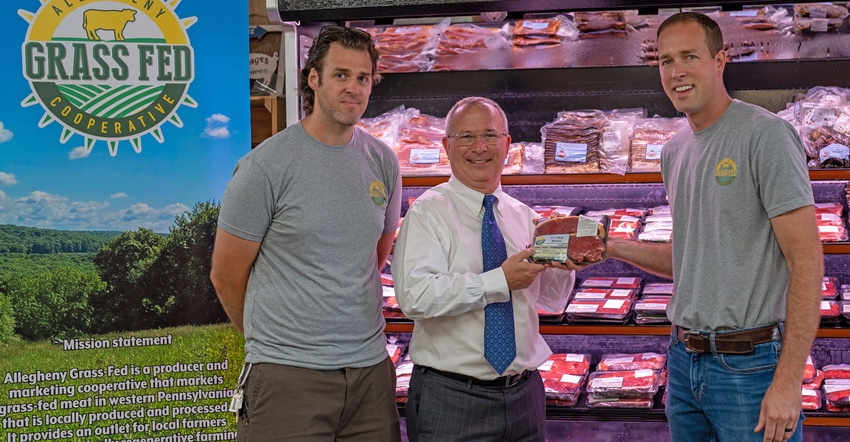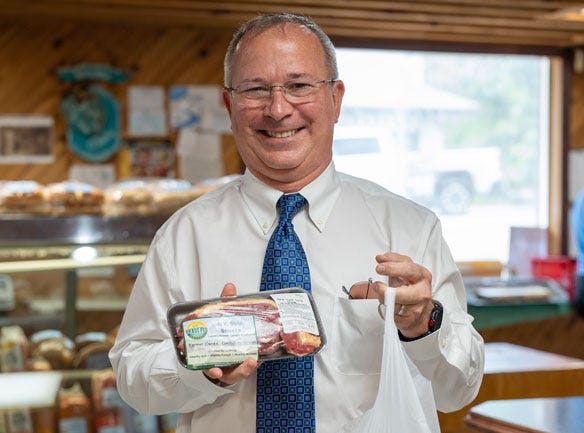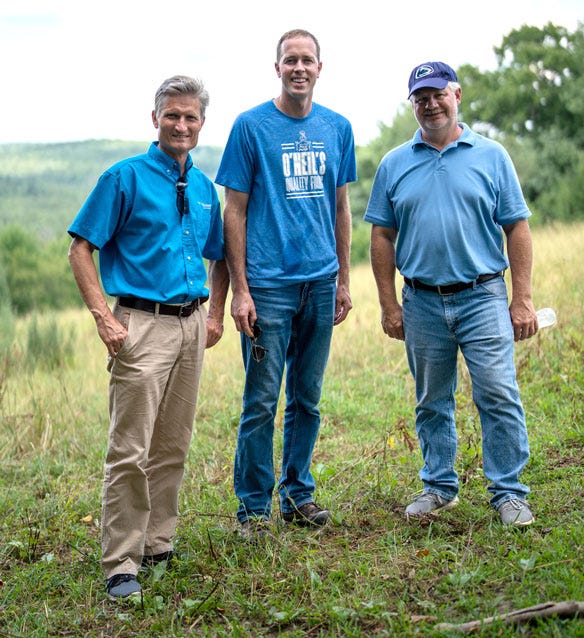Allegheny Grass Fed Cooperative held its first sale of product earlier this summer.

Editor’s note: With concerns over COVID-related food shortages and the consolidation of the beef packing industry, there is renewed interest in expanding local beef processing and marketing. This is the second of three stories this week highlighting new beef marketing initiatives in Michigan and Pennsylvania.
What started as a research project to study the effects of integrating no-till, cover crops and grazing on soil health has led to the formation of a grass-fed beef cooperative in western Pennsylvania.
Earlier this summer, the Allegheny Grass Fed Cooperative held its first sale of product at a small grocery store in Shippenville, Pa. It was a big moment for the small five-member cooperative, which was formally incorporated last July, and last August held its first board of directors election.
The cooperative sold its first labeled cuts of meat at O’Neill’s Quality Foods in an event attended by several people, including Russell Redding, Pennsylvania secretary of agriculture.
Meat sold through the cooperative must come from 100% grass-fed animals — only Red Devons, and Red and Black Angus, for now — with no GMO inputs. It is not a 100% pasture program — hay can be fed in the wintertime — but growers are encouraged to keep their animals on pasture for as long as possible, which Peter Zimmer, coordinator of the cooperative, says is about 300 days for western Pennsylvania.
He says the limited number of cattle breeds are to ensure the cooperative’s nutrition and grade standards are met.
From soil health to beef
According to the website for Allegheny Grass Fed, the cooperative’s beginnings go back to the mid-2010s when well-known grazier Russ Wilson and Penn State soil management professor Sjoerd Duiker teamed up for a study on the effects of various crop management practices on soil health.
After seeing that Wilson was not getting a premium for his grass-fed beef and that direct marketing was taking too much of his time, Duiker, according to the website, asked Wilson if he was interested in forming a “grass-fed beef community” to market his product.
But according to AJ O’Neill, a board member and grower who was brought on in the latter stages of the cooperative’s development, the initial idea fizzled after differences over what the cooperative should look like.
“A lot of us are independent,” O’Neill says. “We’re so used to doing things on our own and building our own thing and having our own customers that the idea of sharing all that information, sometimes farmers are reluctant to give that up.”
In early 2020, a new steering committee was formed. A partnership with Keystone Development Center to pursue a formal cooperative model was agreed upon, and Duiker, according to the website, applied for and got a USDA Farmer Market and Local Food Promotion Program grant to help the cooperative get going.
Zimmer, who was hired part time by the cooperative in April and has a background in food aggregation and community development, says a lot of pieces need to be developed, including streamlining the onboarding of new members, and ensuring production standards are being met.
Right now, all farm inspections and quality checks are being done on a volunteer basis by the farm’s five board members.
Farms on the board range in operation from 50 head to more than 250 head. But not all board members sell their beef through the cooperative yet.
Providing a market
O’Neill, who raises 49 head of Red Devons on 70 acres that he leases from his parents and other landowners, is also the head butcher of his family’s grocery store, O’Neill’s Quality Foods.
He is not selling his beef into the cooperative. Rather, he’s buying from the cooperative to fill a need in his store. He’s been so backlogged filling orders for existing customers, he says, that he hasn’t been able to offer a separate line of grass-fed beef cuts.
“So this kind of gave me the opportunity to offer that line all the time,” he says.
Though the grass-fed product may not be as tender, consistent or “melt in your mouth” as grain-finished beef might be, he says that he prefers the flavor of grass-fed and knowing the animals were raised on a strictly grass diet.
The grass-fed beef fetches a $1-a-pound premium over other beef products he sells. “And it is selling out,” O’Neill says, adding that he’s been offering steaks, roasts, flavored burgers and even grass-fed all beef hot dogs. “And we can offer it fresh. So the idea of having individuals come in and be able to do like a cut to order, I think gives us a niche, makes us unique.”
Filling the pieces
But a lot of pieces must be filled if this small cooperative will have any impact for growers outside its small area, which is between Erie and Pittsburgh.
Animals are being slaughtered at Whiting Family Foods, a small USDA-certified plant in New Wilmington. Because of its small capacity, lack of cold storage, and the fact that sales channels are still being developed, Zimmer says the cooperative is only slaughtering one or two animals at a time.
The cooperative manages the cut list, as well as packaging, labeling and distribution. Each label has a line on the package telling customers where the animal was raised. Zimmer says that sales outlets are eager to get product, but labeling has been the biggest issue thus far.

Matthew Lerch was the first customer to buy Allegheny Grass Fed meat during its first sale in late July.
Any changes on the label must go through a USDA approval process to ensure what’s being advertised is accurate. This has been challenging, he says, because each label has a different farm address, and this is where things can slow down.
“It’s pretty slow, and it’s pretty clumsy,” Zimmer says. “Every time something changes or is incorrect, you have to go through a tedious process to make it right, and it’s very unclear. It’s kind of like this very long iterative process, and it’s has been a struggle.”
Finding a processor hasn’t been easy either. Some are out six months or longer, and each processor cuts meat different. “So we have to be very specific about cuts, portions, size, and this can be tricky to do,” Zimmer says. “It’s really important from a consumer standpoint to have clear expectations on what you’re going to get, especially when we’re talking about online markets.”
All the board members already sell their own beef through other channels, which begs the question: What is the incentive of promoting and pushing this cooperative model? For Zimmer, more sales outlets are better.
“It’s both a way to access new markets and potentially expand somebody’s sales in their herd,” he says. “So if you’re somebody who … has 50 head but maybe have enough land for 75 or 100, but you haven’t reached that threshold of return on investment and pricing out that cost of expansion, this is probably a good opportunity because all of the sales outlets are kind of baked into the co-op.
“The other angle is building a community of like-minded folks. These different growers all subscribe to the philosophies and ideas of grass-fed, regenerative agriculture, like the small food, local food movement. So being part of that community and supporting one another is also an incentive. And being able to upload some of the back-end work of marketing, sales, inventory, distribution and really relying on the co-op to take that work in, so farmers can get back to growing and raising food, and being able to step back from that day-in, day-out business management component.”
Preserving the farm
O’Neill wants the cooperative to succeed for another reason: the next generation.
His farm has been in his family since the 1940s; his grandfather milked dairy cows until the late 1980s.
For 15 years, the farm ground was leased to neighboring farmers who cut hay. Then O’Neill started rotationally grazing in the 2010s, looking to raise some cattle for the family store.
He mostly sells his animals for breeding stock and freezer beef; the former is bringing in more money right now.

Allegheny Grass Fed started as a research project to study the effects of integrating no-till, cover crops and grazing on soil health. Leaders of the project were Sjoerd Duiker, Penn State soil management professor; AJ O’Neill, president of the Allegheny Grass Fed board; and Ron Kreiss, secretary and treasurer of the board.
O’Neill says he is eager to buy more beef from the cooperative for his store and to develop a local beef market that can support younger farmers.
“That’s really where a lot of us on the board of directors sees this, is for the next generation," he says. “We want to have opportunities for these next kids that are … even kids that are graduating high school right now.”
If successful, Zimmer says the cooperative could eventually expand to include another five or six producers, and make the region a local hub for grass-fed beef production. The COVID pandemic, he says, illuminated problems in the beef industry, especially on the packing and processing side.
“That was a test drill for what could happen,” he says. “And now producers are taking steps to improving that.”
“The sky's the limit for it, honestly,” O’Neill says of the cooperative. “We're starting small and making sure we want to establish some good markets.”
About the Author(s)
You May Also Like





